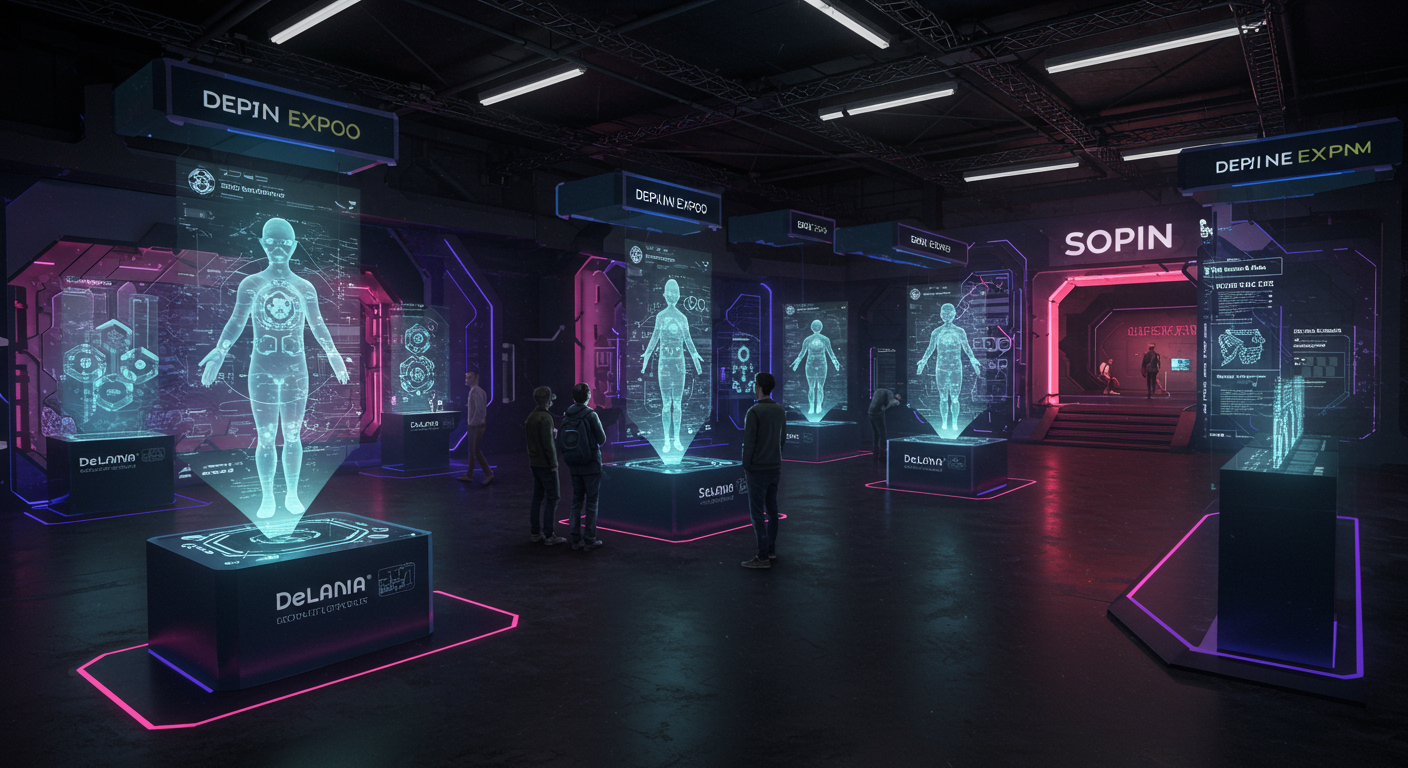DePIN, Solana, and the Dawn of a Decentralized World: A Beginner’s Guide
John: Alright, Lila, let’s dive into one of the most exciting and tangible sectors in the Web3 space. We’re talking about DePIN, which stands for Decentralized Physical Infrastructure Networks. It’s a mouthful, I know, but the concept is revolutionary. We’re seeing a huge convergence around this idea, especially with high-performance blockchains like Solana, and it’s all culminating in major events like the upcoming DePIN Expo.
Lila: Okay, John, hold on. “Decentralized Physical Infrastructure Networks.” That sounds incredibly abstract. Let’s break it down for our readers who are maybe hearing this for the first time. When you say “physical infrastructure,” are we talking about real-world things? Like, actual hardware?
John: Exactly. That’s the key. Forget, for a moment, the purely digital assets like JPEGs or cryptocurrency tokens. DePIN is about using blockchain technology and crypto-economic incentives to build and maintain real-world infrastructure. Think Wi-Fi hotspots, environmental sensors, data storage servers, or even energy grids. Instead of a single, massive corporation like AT&T or Amazon Web Services owning and operating everything, DePIN creates a network owned and operated by its users.
Lila: So, it’s like a community-owned internet provider or a user-powered cloud storage service? People contribute their own hardware—like a small sensor or a part of their hard drive—and get rewarded for it, probably with tokens?
John: You’ve got it in one. It’s a bottom-up approach. Individuals and small businesses are incentivized with cryptocurrency tokens to deploy and maintain these physical devices. This creates a more resilient, cost-effective, and permissionless (open to anyone) infrastructure than the traditional, centralized models we’ve relied on for decades. It’s about taking the principles of decentralization and applying them to the physical world, bridging the gap between digital and tangible assets.

Basic Information: What is the DePIN Expo and Why Solana?
Lila: That makes sense. It’s a huge idea. Which brings us to the DePIN Expo. I’ve seen it all over X and crypto news sites. What’s the big deal? Is it just another tech conference?
John: It’s a bit more focused than a general tech conference. The DePIN Expo, particularly the one in Hong Kong, is set to be a major showcase for this entire sector. Think of it as the premier gathering for all the projects, developers, investors, and enthusiasts who are building these networks. It’s where the theoretical meets the practical. Companies will be showcasing real-world applications, from decentralized mapping projects to community-run 5G networks. And a major partner for the 2025 event is the Solana Foundation.
Lila: And that’s a big deal because…? Why Solana specifically? There are lots of blockchains out there.
John: That’s the crucial question. DePIN networks generate a massive amount of small, frequent transactions. Imagine thousands of sensors all reporting data every minute. Or thousands of Wi-Fi hotspots processing user payments. To handle this, you need a blockchain that is incredibly fast, has very low transaction fees, and can scale to handle millions of users and devices. Solana was designed from the ground up for this kind of high-throughput activity. Its unique architecture, which we can get into later, makes it an almost perfect match for the demands of DePIN.
Lila: So, if other blockchains are like city roads, good for regular traffic, Solana is like a massive, multi-lane superhighway built specifically for an enormous fleet of tiny, super-fast delivery drones? The “drones” being all those tiny data packets from the DePIN devices.
John: That’s a fantastic analogy, Lila. It perfectly captures the essence of it. The cost and congestion on other networks would make most DePIN models unfeasible. Solana provides the robust, high-performance foundation that allows these ambitious real-world projects to actually be built and operated affordably and at scale.
Supply Details: Powering the Network
Lila: Okay, let’s talk about the “supply” side of DePIN. We said people contribute hardware. What does that look like in practice? And what’s the “supply” of projects on Solana? Is it a crowded space?
John: The supply model is what makes DePIN so innovative. It’s often called the “flywheel effect.” Let’s take a project like Helium, which started on its own blockchain and has since migrated to Solana.
- Incentivize Supply: Helium wanted to build a decentralized wireless network. They offered their native token, HNT, as a reward to anyone who would buy and set up a Helium hotspot in their home or office. This created the initial supply of network coverage.
- Create Demand: As the network grew, it became useful for companies that needed low-cost connectivity for things like IoT sensors—tracking scooters, monitoring air quality, etc. These companies pay to use the network.
- Reinforce Value: The fees paid by users are then used to buy back and “burn” (permanently remove from circulation) the HNT tokens, which can create positive value pressure on the token, further incentivizing hotspot owners.
This model bootstraps the expensive, physical side of the network without needing massive upfront capital investment from a single company.
Lila: That’s a really clever loop. It turns users into stakeholders. So, is Solana seeing a lot of projects adopt this model? Is there a good “supply” of DePIN applications for users to explore?
John: Absolutely. The Solana DePIN ecosystem is exploding. It’s one of the most vibrant sectors on the chain. We have projects like:
- Hivemapper: A decentralized mapping network. Contributors install a dashcam, drive around, and map the world. They earn HONEY tokens for the data they collect, which is then used to create a more up-to-date and affordable alternative to Google Maps.
- Render Network: A decentralized GPU rendering service. People with powerful gaming computers can “rent out” their idle GPU power to artists and studios who need to render complex 3D graphics or animations. They’re paid in RNDR tokens.
- Teleport: A decentralized ride-sharing service, like a community-owned Uber. Drivers and riders are both participants in the network, with fairer revenue splits and more transparent rules.
The supply of projects is growing daily because Solana makes it easy and cheap for these developers to build. Recent reports show Solana’s DePIN ecosystem generated millions in revenue in just the first half of this year, which is a strong indicator of its health and growth.
Lila: It’s cool because it feels more participatory. Instead of just being a consumer of a service like Google Maps or Uber, you can actually be a part of building it and share in the value you help create. That’s a powerful shift in perspective for my generation.
Technical Mechanism: The Solana Secret Sauce
John: And that participatory element can only exist if the underlying technology is seamless. This brings us to the technical mechanism. The reason Solana can handle this “superhighway” of transactions is due to its unique consensus mechanism (the process by which the network agrees on the state of the ledger). It’s called Proof-of-History (PoH).
Lila: Proof-of-History? Not Proof-of-Work like Bitcoin or Proof-of-Stake like Ethereum? What’s the difference? Please use another one of your great analogies, John!
John: Happy to. Imagine a traditional blockchain is like a group of people in a room trying to agree on the exact order of events that just happened. They all have to talk to each other, show their notes, and vote on the sequence. It’s slow and requires a lot of communication. This is, very simply, how Proof-of-Work and Proof-of-Stake work—they are primarily about achieving consensus on the order of transactions.
Lila: Okay, a slow, bureaucratic meeting. I get it.
John: Now, imagine in that same room, there’s a giant, public clock that stamps every single event with a verifiable, cryptographic timestamp the instant it happens. Before anyone even needs to “vote,” they can all look at the clock’s ledger and see the undeniable order of events. That’s what Proof-of-History does. It creates a verifiable timeline of transactions. This allows validators (the computers securing the network) to process transactions in parallel, without having to constantly wait for consensus on the order from the entire network. It dramatically increases the speed and throughput.
Lila: So PoH is like a super-trustworthy, un-hackable timestamping machine that makes everything else more efficient. And this is what allows for the thousands of tiny transactions from, say, Hivemapper dashcams or Helium hotspots to be processed almost instantly and for fractions of a penny?
John: Precisely. This is combined with other Solana innovations like:
- Tower BFT: A PoH-optimized version of the Byzantine Fault Tolerance algorithm, which is the part that handles the voting and consensus.
- Turbine: A protocol for breaking down transaction data into smaller packets and broadcasting it through the network, which is much faster than sending whole blocks.
- Sealevel: The ability to run smart contracts (self-executing code on the blockchain) in parallel, something most other major blockchains cannot do.
All these components work together to create a blockchain that can theoretically handle tens of thousands of transactions per second for incredibly low fees, making it the ideal home for DePIN.

Team & Community: The People Behind the Protocols
Lila: Technology is only as good as the people building and using it, right? Who are the key players in the Solana and DePIN space? Is it just a bunch of anonymous developers?
John: Far from it. The ecosystem is anchored by the Solana Foundation, a non-profit organization based in Switzerland. Their mission is to grow and secure the Solana network. They provide grants, support developers, and champion adoption, such as their major partnership with the DePIN Expo 2025. They act as stewards of the ecosystem. Then you have Solana Labs, the core engineering team that originally built the protocol, led by figures like Anatoly Yakovenko. His vision for a high-performance blockchain was fundamental.
Lila: And what about the community? I see a lot of activity on X from accounts like @solana_devs and @DePIN_Union. It seems very grassroots.
John: It is. The community is arguably the most critical part. It’s a global network of developers, creators, validators, and users. The developer community is particularly strong. Solana has invested heavily in making it easy to build on the platform, which has attracted a huge talent pool. Then you have the project-specific communities. The people running Hivemapper dashcams or Render nodes form tight-knit groups on platforms like Discord and Telegram. They share tips, help troubleshoot, and advocate for the project. This distributed, passionate user base is the lifeblood of any DePIN project.
Lila: It’s like a fandom, but for technology. People feel a sense of ownership, which you just don’t get with traditional tech companies. That community aspect is a huge selling point. It drives loyalty and organic growth in a way that marketing dollars can’t quite replicate.
Use-Cases & Future Outlook: Beyond the Hype
John: Let’s ground this in more examples because that’s where the future potential really shines. We’ve mentioned wireless networks, mapping, and GPU rendering. But DePIN can be applied to almost any physical system.
Lila: Give me some more. What are the really futuristic, mind-blowing applications people are working on?
John: Think about energy. Projects are emerging that allow homeowners with solar panels to sell their excess energy directly to their neighbors over a decentralized grid. The blockchain handles the metering and payments automatically. This creates more resilient local energy markets and promotes renewable energy. Another area is data infrastructure. Instead of relying solely on Amazon’s S3 or Google Drive, projects are building decentralized storage networks where you rent out your unused hard drive space, creating a global, censorship-resistant, and potentially much cheaper cloud.
Lila: So, my computer’s junk drawer of unused gigabytes could actually be earning me money while helping build a freer internet? That’s cool. What about things that blend with other emerging tech, like AI?
John: That’s a key convergence being highlighted at the DePIN Expo. AI models require two things: massive amounts of data for training and massive amounts of computational power. DePIN can provide both.
- Decentralized Data: Networks of sensors (weather, traffic, environmental) can provide real-time, verifiable data sets to train AI models. The blockchain ensures the data is authentic and not tampered with.
- Decentralized Compute: Networks like Render or other decentralized GPU projects can provide the distributed computational power needed to train these models, often at a lower cost than centralized cloud providers.
The future outlook is a world where smart devices, AI, and physical infrastructure are all seamlessly interconnected and coordinated through high-performance blockchains like Solana. We’re talking about truly smart cities, autonomous supply chains, and predictive environmental monitoring, all built on a foundation of user-owned hardware.
Competitor Comparison: Is Solana the Only Game in Town?
Lila: It sounds like Solana is the perfect fit, but it can’t be the only blockchain trying to corner the DePIN market. Who are the other contenders, and what makes Solana’s approach different?
John: You’re right, it’s a competitive space. There are other blockchains that are very focused on this niche. A notable one is IoTeX, which has been focused on the “Internet of Things” and DePIN from its inception. They’ve built a modular platform specifically for connecting IoT devices to the blockchain. Another major player is, of course, Ethereum, but not the main chain itself. The competition there comes from its vast ecosystem of Layer 2 scaling solutions (protocols built on top of Ethereum to make it faster and cheaper), which could potentially be used for DePIN applications.
Lila: So how does Solana stand out against a dedicated platform like IoTeX or the massive ecosystem of Ethereum?
John: The key differentiators for Solana are:
- Unified Composability: On Solana, all applications exist on a single, ultra-fast Layer 1 blockchain. This means a DePIN project can seamlessly interact with a DeFi (Decentralized Finance) protocol or a gaming application on the same chain without needing complex “bridges” or dealing with fragmented liquidity. Everything is in one place, which makes development easier and the user experience smoother. Ethereum’s Layer 2s are powerful, but they can be somewhat isolated from each other.
- Speed and Finality: Solana’s raw speed and near-instant transaction finality (the guarantee that a transaction cannot be reversed) are still class-leading. For real-time applications, like a decentralized ride-sharing app needing to confirm a ride instantly, this is a critical advantage.
- Developer and Mobile Ecosystem: Solana has pushed aggressively into the mobile space with the Solana Mobile Stack (SMS) and Saga phone. Since many DePIN applications will involve mobile phones interacting with hardware, having a strong, native mobile strategy is a significant advantage. The developer community is also incredibly active and growing fast.
While IoTeX is deeply specialized and Ethereum has a massive network effect, Solana’s unique combination of a single-shard high-performance architecture and a rapidly growing ecosystem makes it an incredibly compelling choice for DePIN builders, as evidenced by the high-profile projects migrating to it.
Risks & Cautions: A Reality Check
Lila: This all sounds amazing, maybe a little too good to be true. As a journalist, I have to be skeptical. What are the risks? What could go wrong for the average person who wants to set up a hotspot or a dashcam?
John: An essential question. The enthusiasm must be tempered with a healthy dose of realism. The risks fall into a few categories. First, technical risk. Solana, for all its strengths, has experienced network outages in the past. While developers have been working diligently to improve stability, and recent upgrades have been proposed to alleviate congestion, the network is still complex and evolving. If the network goes down, the DePIN services built on it go down too.
Lila: That’s a big one. What else?
John: Second, market and economic risk. The incentive “flywheel” we discussed depends on the project’s token having value. If the token price collapses due to market volatility or a failure to attract demand for the service, the incentive for people to run their hardware disappears. Early contributors could be left with expensive hardware that no longer generates a return. It’s a speculative endeavor, and the token is not a guaranteed salary.
Lila: So you could buy a $500 device and see the rewards drop to near zero if the crypto market tanks or the project just doesn’t take off. That’s a real risk for the average user.
John: Precisely. Finally, there’s regulatory risk. DePIN operates in a gray area in many jurisdictions. Are you a telecommunications provider if you run a Helium hotspot? What are the data privacy implications of a decentralized mapping network? Governments are still figuring out how to approach decentralized technologies, and future regulations could significantly impact certain DePIN models. It’s a frontier, and the rules are not yet written.

Expert Opinions & Analyses
Lila: What are the big thinkers in the space saying? Are VCs and industry analysts as bullish as the project founders?
John: The general sentiment from the more forward-thinking analysts and venture capital firms is overwhelmingly positive. Messari, a prominent crypto research firm, has called DePIN one of the most important crypto theses for the coming decade. They see it as a clear case of crypto finding a powerful product-market fit outside of pure finance. The ability to use crypto-incentives to coordinate the deployment of physical infrastructure at a fraction of the cost of traditional models is seen as a genuine paradigm shift.
Lila: So they see the “real-world” connection as the key?
John: Yes. For years, a common criticism of crypto was, “What can you actually *do* with it?” DePIN provides a concrete answer. It’s not just about financial speculation; it’s about building tangible things. Analysts often point to the massive total addressable markets—telecom, cloud computing, energy, mapping—and see DePIN as a technology that can capture a slice of those multi-trillion dollar industries. However, the same analysts also caution about the risks we just discussed. The consensus is “massive potential, but early days and high risk.”
Lila: I’ve also seen a lot of chatter on social media about how DePIN could empower developing nations, allowing them to build out infrastructure like internet access without relying on foreign corporations or government monopolies. It feels like a very hopeful narrative.
John: That is a very powerful and recurring theme. The permissionless nature of DePIN means that a community in a rural area, underserved by big telecom, could theoretically band together to build their own local wireless network. It lowers the barrier to entry for essential infrastructure. This aspect of empowerment and self-sovereignty is a huge part of the expert analysis and the overall vision for the technology.
Latest News & Roadmap: The Road to DePIN Expo 2025
Lila: Let’s bring it back to the near future. The SERPs are buzzing about the DePIN Expo 2025. What’s the latest news, and what should people expect from the event and the Solana ecosystem leading up to it?
John: The biggest piece of news, as we’ve touched on, is the Solana Foundation’s formal partnership with the DePIN Expo in Hong Kong, scheduled for August 27-28, 2025. This isn’t just a sponsorship; it’s a strategic move. The Foundation will be there to actively showcase the top DePIN projects in its ecosystem, driving home the message that Solana is the premier platform for real-world adoption. This provides a huge spotlight and validation for the projects building on Solana.
Lila: What kind of things will be showcased? Will attendees be able to see this technology in action?
John: That’s the goal. The agenda is expected to revolve around three major themes: Real-World Assets (RWA), Artificial Intelligence (AI), and the Internet of Everything (IoE). Attendees should expect:
- Live Demos: Projects like Hivemapper and Helium will likely have interactive demonstrations of their hardware and the data they are collecting in real-time.
- Developer Workshops: Solana’s core developers will be on hand, running workshops for builders who want to get started in the DePIN space.
- Major Announcements: Conferences like this are prime venues for projects to announce new partnerships, technological breakthroughs, or roadmap updates.
In the broader Solana roadmap, the focus remains on network performance and stability. Core developers have recently proposed upgrades to increase the gas limit, which would help alleviate network congestion and better handle the massive activity that DePIN projects bring. It’s a continuous effort to make the “superhighway” even wider and more efficient.
Lila: So, the expo is both a celebration of what’s been built and a launchpad for what’s next. It’s the place to be if you want to get a real feel for the future of this technology.
Frequently Asked Questions (FAQ)
Lila: John, let’s wrap up with a quick FAQ section. I’ll ask some of the most common questions a beginner might have, and you can give the straight answer.
John: An excellent idea. Fire away.
Lila: Okay, first one: Do I need to be a tech expert to participate in a DePIN network?
John: Not at all. For most projects, if you can plug in a Wi-Fi router or install a dashcam in your car, you have the technical skills required. The projects are designed to be as “plug-and-play” as possible. The complexity is on the backend, not the user end.
Lila: Next: Is earning crypto from DePIN a reliable income?
John: No. It should be viewed as a speculative reward, not a reliable income. The value of the tokens you earn can be extremely volatile and depends on the success of the project and overall market conditions. Participate because you believe in the technology, not as a guaranteed money-maker.
Lila: Good distinction. Why is the DePIN Expo being held in Hong Kong?
John: Hong Kong is positioning itself as a major hub for Web3 and digital assets in Asia. It has a progressive regulatory stance and is a gateway to the massive Asian market. Hosting the expo there signals the global nature of this movement and its importance in the region.
Lila: Makes sense. Is Solana the “best” blockchain for DePIN?
John: “Best” is subjective, but it is arguably one of the most *suitable* blockchains for DePIN right now due to its unique combination of high speed, low cost, and a single, composable architecture. Its strong momentum and growing ecosystem make it a top choice for many developers, but other chains are also building compelling solutions.
Lila: Final question: How can I get started or learn more?
John: The best way is to start exploring. Follow accounts like DePIN Union and the official Solana account on X. Visit the websites of projects like Helium, Hivemapper, or Render. Read their whitepapers. Join their Discord communities and ask questions. And if you can, attending an event like the DePIN Expo is an immersive way to learn. Start small and stay curious.
Related Links
John: This has been a great discussion, Lila. It’s a complex topic, but I think we’ve shed some light on why there’s so much excitement. DePIN, especially on a powerful chain like Solana, represents a fundamental shift in how we might build the physical infrastructure of the future. It’s about decentralizing not just finance, but the real world.
Lila: I agree! It connects the abstract world of blockchain to things we can actually see and touch, which I think is what the space needs to achieve mainstream adoption. It’s definitely a sector I’ll be watching closely, especially around the DePIN Expo next year.
John: A final, important note for our readers: The information discussed in this article is for educational and informational purposes only. It does not constitute financial or investment advice. The cryptocurrency and DePIN sectors are highly volatile and carry significant risks. Always do your own research (DYOR) and consult with a qualified financial advisor before making any investment decisions.
